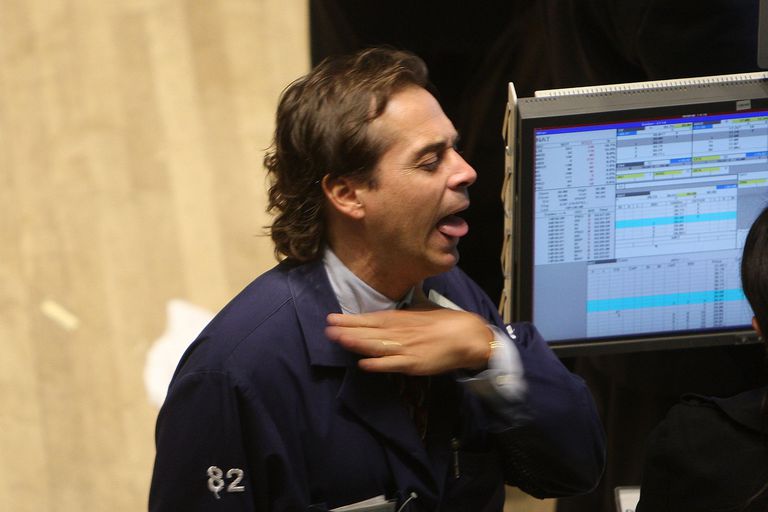So, the better course, (unless you are young and have the courage of a gambler in Las Vegas), is to become a long term investor.
What is a safe long term investor?
My friend who I'm talking about here would tell you this about becoming a long term investor:
He would say you need to put $3000 in a savings account first over and above whatever you normally have in your checking accounts. (However, I would recommend at least $10,000 in savings accounts)
Why? Because if you are serious about being a long term investor the only thing you take out and keep is your dividends for years at a time. And often if everything is okay you simply plow your dividends back in by buying more stocks when the opportunities arise.
So, a safeway to become a long term investor is to first save $3000 to $10,000 minimum in savings accounts BEFORE you invest in the stock market long term.
Why?
Because you are planning never to liquidate your stocks once you buy them. You are planning to keep those stocks sort of like my relative who bought $50,000 worth of General Electric in the 1950s only to have it accrue to $3,000,000 by about 2000 AD.
Will your stocks do this?
No. not necessarily unless you get something really good that keeps going up.
So, yearly or sooner you look at your stocks and see what is performing for you and what isn't and you sell the stocks not performing for you and buy better ones who are doing better. You keep doing this for the next 50 years or so until one or more of your stocks goes from $50,000 to $3,000,000 too.
So, over time you slowly sell non-performing stocks and replace them with ones that will do better for you over time.
And meanwhile if you are smart your stocks are dividend bearing stocks so you have yearly income that makes the risk of the stock market worthwhile for you to bear.
Meanwhile you also have health insurance because if you don't have medical care during all this one catastrophic illness could completely wipe you and your money and investments out too.
So, how do people become rich over time?
This is one way it happens if you are disciplined enough.
However, I also saw the crash of 2008 when the market fell to 6500 points
But even then, imagine if you were heavy into cash and then saw this crash as an opportunity. Then if you bought diversified blue chip stocks with Dividends, imagine where you could be today or recently with 27,000 to 28,000 stock tickers? If you look at the market from 1929 until now it basically has done nothing but go up over time (with jitters different places) but generally since 1929 it has always headed upwards.
begin quote from:
Stock Market Crash 2008: Date, Causes - The Balance
https://www.thebalance.com › ... › US Economy › GDP and Growth › Recessions
Missing: 6900
US Economy
Stock Market Crash of 2008
Follow the Timeline to Understand Why It Crashed

The Dow hit its pre-recession high on October 9, 2007, closing at 14,164.43. Less than 18 months later, it had dropped more than 50 percent to 6,594.44 on March 5, 2009.
That wasn't the largest decline in history. During the Great Depression,
the stock market dropped 90 percent. But that took three years. What
caused this crash? Follow the timeline below to understand exactly how
it happened.
2007
The Dow opened the year at 12,459.54. It rose despite growing concerns about a housing market slowdown. On November 17, 2006, the Commerce Department warned that October's new home permits were 28 percent lower than the year before. But government officials didn't think the housing slowdown would affect the rest of the economy. In fact, they were relieved that the overheated real estate market appeared to be returning to normal.But as home prices fell, they triggered subprime mortgage defaults. By August 2007, the Federal Reserve recognized that banks didn’t have enough liquidity to function. The Fed began adding liquidity by buying banks’ subprime mortgages. By October, some economists warned about the widespread use of collateralized debt obligations and other derivatives.
By late November, Treasury Secretary Hank Paulson launched a bank-funded Superfund to purchase toxic debt.
As the year drew to a close, the Bureau of Economic Analysis revised its estimate of growth up. It said that the nation’s gross domestic product had increased 0.5 percent in the third-quarter. Its prior estimate said it had shrunk 0.5 percent.
It seemed the U.S. economy could
shrug off a housing downturn and banks’ liquidity constraints. The Dow
ended the year just slightly off its October high, at 13,264.82.
2008
At the end of January, the BEA revised its fourth quarter GDP growth estimate down. It said growth was only 0.6 percent. The economy lost 17,000 jobs, the first time since 2004. The Dow shrugged off the news, and hovered between 12,000 and 13,000 until March.On March 17, the Federal Reserve intervened to save the failing investment bank Bear Stearns, the first casualty of the subprime mortgage crisis. The Dow dropped to an intra-day low of 11,650.44, but seemed to recover. In fact, many thought the Bear Stearns rescue would relieve investors. They expected the intervention would keep avoid a bear market. By May, the Dow rose above 13,000. It seemed the worst was over.
In July 2008, the subprime mortgage crisis threatened government-sponsored agencies Fannie Mae and Freddie Mac. They required a government bailout. The Treasury Department guaranteed $25 billion of their loans and bought shares of Fannie's and Freddie's stock. The FHA guaranteed $300 billion in new loans. The Dow fell, closing at 10,962.54 on July 15.
It rebounded, and remained above 11,000 for the rest of the summer.
September 2008
The month started with chilling news. On Monday, September 15, 2008, Lehman Brothers declared bankruptcy. The Dow dropped 504.48 points.On Tuesday, September 16, the Fed announced it was bailing out insurance giant AIG. It made an $85 billion "loan" in return for 79.9 percent equity, effectively taking ownership. AIG had run out of cash. It was scrambling to pay off credit default swaps it had issued against now-failing mortgage-backed securities.
On Wednesday, September 17, money market funds lost $144 billion. That's where most businesses park their overnight cash. Companies had panicked, switching to even safer Treasury notes. They did this because Libor rates were high. Banks had driven up rates because they were afraid to lend to each other.
The Dow fell 449.36 points.
On Thursday, September 18, markets rebounded 400 points. Investors learned about a new bank bailout package.On Friday, September 19, the Dow ended the week at 11,388.44. It was only slightly below its Monday open of 11,416.37. The Fed established the Asset-Backed Commercial Paper Money Market Mutual Fund Liquidity Facility. It loaned $122.8 billion to banks to buy commercial paper from money market funds. The Fed's announcement confirmed that credit markets were partially frozen and in panic mode.
On Saturday, September 20, Hank Paulson and Ben Bernanke sent the bank bailout bill to Congress. The Dow bounced around 11,000 until September 29, when the Senate voted against the bailout bill. The Dow fell 777.68 points, the most in any single day in history. Global markets also panicked, as well:
- The MSCI World Index dropped 6 percent in one day, the most since its creation in 1970.
- Brazil's Ibovespa was halted after dropping 10 percent.
- The London FTSE dropped 15 percent.
- Gold soared to over $900 an ounce.
- Oil dropped to $95 a barrel.
October 2008
Congress finally passed the bailout bill in early October, but the damage had already been done. The Labor Department reported that the economy had lost a whopping 159,000 jobs in the prior month. On Monday, October 6, the Dow dropped 800 points, closing below 10,000 for the first time since 2004.The Fed tried to prop up banks by lending $540 billion to money market funds. The funds needed the cash to meet a continuing barrage of redemptions. Since August, more than $500 billion had been withdrawn from money markets.
JPMorgan Chase managed the Fed's Money Market Investor Funding Facility. It purchased up to $600 billion of certificates of deposit, bank notes, and commercial paper that would come due in 90 days. The remaining $60 billion came from the money markets themselves. But they were also purchasing commercial paper from the MMIFF.
The Fed quickly lowered the fed funds rate to just 1 percent. But the Libor bank lending rate rose to its high of 3.46 percent. The Fed also coordinated a global central bank bailout.
The Dow responded by plummeting 13 percent throughout the month. By the end of October, the BEA released more sobering news. The economy had contracted 0.3 percent in the third quarter. The nation was in recession.
November 2008
The month began with more bad news. The Labor Department reported that the economy had lost a staggering 240,000 jobs in October. The AIG bailout grew to $150 billion. Treasury announced it was using part of the $700 billion bailout to buy preferred stocks in the nations' banks. The Big Three automakers asked for a federal bailout. By November 20, 2008, the Dow had plummeted to 7,552.29, a new low. But the stock market crash of 2008 was not over yet.December 2008
The Fed dropped the fed funds rate to zero, its lowest level in history. The Dow ended the year at a sickening 8,776.39, down almost 34 percent for the year.2009
In a burst of optimism, the Dow climbed to 9,034.69 on January 2, 2009. Investors believed the new Obama administration could tackle the recession with his team of economic advisers. But the bad economic news continued. The Dow plummeted to its bottom of 6,594.44 on March 5, 2009.Soon afterward, Obama's economic stimulus plan instilled the confidence needed to stop the panic. On July 24, 2009, the Dow reached a higher high. It closed at 9,093.24, beating its January high. For most, the stock market crash of 2008 was over.
Aftermath
Investors bore the emotional scars from the crash for the next four years. On June 1, 2012, they panicked over a poor May jobs report and the eurozone debt crisis. The Dow dropped 275 points, and the 10-year benchmark Treasury yield dropped to 1.443 during intraday trading. This was the lowest rate in more than 200 years. It signaled that the confidence that evaporated during 2008 had not quite returned to Wall Street.In 2013, the stock market finally recovered. In the first six months, it gained more points than in any year on record. Stock prices rose faster than earnings, creating an asset bubble. The Dow set over 250 closing records until February 2018. Fears of inflation and higher interest rates almost sent the Dow into a correction. Like many other past stock market crashes, it did not lead to a recession.

No comments:
Post a Comment